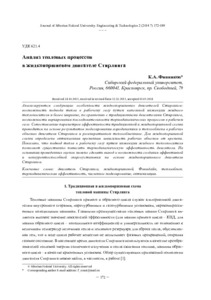Анализ тепловых процессов в жидкопоршневом двигателе стирлинга
Скачать файл:
URI (для ссылок/цитирований):
https://elib.sfu-kras.ru/handle/2311/10350Автор:
Финников, К.А.
Finnikov, Konstantin А.
Дата:
2014-03Аннотация:
Анализируются следующие особенности жидкопоршневых двигателей Стирлинга:
возможность подвода тепла к рабочему газу путем капельной инжекции жидкого
теплоносителя и более широкие, по сравнению с традиционными двигателями Стирлинга,
возможности варьирования последовательности термодинамических процессов в рабочем
газе. Сопоставление параметров эффективности традиционной и жидкопоршневой схемы
проводится на основе результатов моделирования аэродинамики и теплообмена в рабочих
объемах двигателя Стирлинга и регенеративном теплообменнике. Для жидкопоршневой
схемы определена оптимальная временная зависимость рабочих объемов от времени.
Показано, что подвод тепла к рабочему газу путем инжекции жидкого теплоносителя
позволяет существенно повысить термодинамическую эффективность двигателя. На
основании проведенных оценок можно сделать вывод о возможности создания эффективной
и конкурентоспособной энергоустановки на основе жидкопоршневого двигателя
Стирлинга Application of the thermodynamic principles of Stirling engine for the power industry can give a large
capability to increase the energy conversion efficiency. However, it is not possible yet to produce
large-scale power facilities competitive with conventional ones on the base of existing technological
implementations of Stirling engine principles. The reason is high costs of Stirling engines caused
by numerous difficulties in operation with high pressure and volatile working gas that is typically
helium or hydrogen. The liquid piston engine can be an alternative approach in that many problems
inherent to a conventional Stirling engine can be eliminated. The analysis of studies of liquid piston
Stirling engines has shown that one of the most attractive direction of this technology development is
associated with the use of liquid metals with low melting temperature (particularly, Na-K eutectic) as
the both working liquid and heat carrier.
A liquid piston Stirling engine is remarkable for the following features. The first is an opportunity of
supplying heat to a working gas during expansion process and rejecting it during compression processes
by means of a liquid heat carrier. The second feature is larger, as compared with the conventional
Stirling engine, opportunity of controlling the operation regime by setting a consequence of expansion
and compression processes in working cavities. These features are analyzed in the present study with
respect to possibility of increase of engine efficiency.
The analysis is carried out on the base of numerical simulation of gas dynamics and heat exchange
in working cavities and regenerative heat exchanger of a Stirling engine. Optimization simulation is
carried out for the purpose of finding out the optimum time dependency of working cavities volumes
that may be realized in a liquid piston engine. It is shown that organization of heat exchange between
a working gas and liquid heat carriers within hot and cold cavities of engine can result in a significant
growth of the engine thermodynamic efficiency. The obtained estimations count in favor of that the
liquid piston Stirling engine can be an effective and competitive power facility

